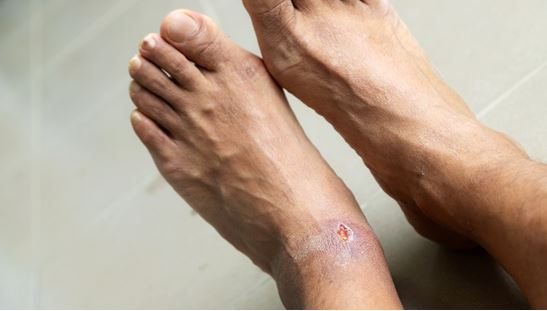Diabetes is a chronic condition that can significantly impact your health, and one of the most vulnerable areas is your feet. High blood sugar levels can cause nerve damage and poor circulation, putting individuals with diabetes at risk for serious foot complications like ulcers, infections, and even amputation.
Proper diabetic foot care is essential to prevent complications and maintain mobility. In this article, we’ll explore why foot care is important, how to care for diabetic feet, and what to do if you develop a diabetic foot ulcer.
Why Is Diabetic Foot Care Important?
Diabetes affects your feet in two major ways:
- Peripheral Neuropathy (Nerve Damage)
High blood sugar can damage the nerves in your feet, causing numbness or tingling. This loss of sensation makes it difficult to feel injuries like cuts, blisters, or sores, which can go unnoticed and worsen over time. - Poor Circulation
Diabetes can reduce blood flow to your feet, slowing down the healing process. Even minor injuries may turn into serious infections or ulcers due to inadequate oxygen and nutrient supply.
Without proper care, these factors can lead to complications such as:
- Diabetic Foot Ulcers: Open sores that don’t heal properly and may become infected.
- Infections: Untreated ulcers or wounds can lead to severe infections, requiring medical intervention.
- Amputation: In extreme cases, infections or gangrene can result in the need for amputation.
Proper diabetic foot care can help prevent these complications and improve your overall quality of life.
How to Care for Diabetic Feet
Daily foot care is crucial for people with diabetes. Here’s how you can protect your feet and avoid complications:
- Inspect Your Feet Daily
Check your feet every day for:
- Cuts, blisters, or sores
- Redness or swelling
- Ingrown toenails or unusual spots
Use a mirror or ask for help if you can’t see the bottoms of your feet.
- Wash and Dry Your Feet Properly
- Wash your feet daily with warm (not hot) water and mild soap.
- Dry them thoroughly, especially between the toes, to prevent fungal infections.
- Keep Skin Moisturized
Apply a lotion to your feet to keep the skin hydrated, but avoid applying it between the toes to reduce the risk of fungal growth.
- Wear Proper Footwear
Choose shoes that fit well and provide ample cushioning. Avoid walking barefoot, even indoors, as this increases the risk of injury.
- Trim Nails Carefully
Cut your toenails straight across to avoid ingrown nails. If you have difficulty, visit a podiatrist for professional nail care.
- Protect Against Extreme Temperatures
Diabetic feet are more sensitive to hot or cold temperatures. Avoid exposing your feet to heating pads or cold surfaces for long periods.
How to Care for Diabetic Foot Ulcers
If you notice an open sore on your foot, it’s important to act quickly. Here’s how to manage a diabetic foot ulcer:
- Clean the Wound
Gently wash the ulcer with saline or a mild antiseptic solution and pat it dry. Avoid using harsh chemicals like hydrogen peroxide, as they can damage healthy tissue.
- Keep It Covered
Apply a sterile bandage or dressing to protect the wound from dirt and bacteria. Change the dressing daily or as directed by your doctor.
- Offload Pressure
Reduce pressure on the ulcer by wearing special footwear or using a walking boot. Pressure can delay healing and worsen the condition.
- Seek Medical Attention
If the ulcer doesn’t show signs of healing within a few days, or if you notice increased redness, swelling, or discharge, see a doctor immediately.
Diabetic Foot Ulcer Treatment Options
Treatment for diabetic foot ulcers varies depending on the severity of the wound. Here are the most common options:
- Debridement
A doctor may remove dead or infected tissue around the ulcer to promote healing. - Infection Management
Antibiotics may be prescribed if the ulcer is infected. In severe cases, hospitalization might be necessary for intravenous antibiotics. - Advanced Wound Care
Specialized dressings, skin grafts, or negative pressure wound therapy (NPWT) can help speed up healing. - Surgical Intervention
If the ulcer doesn’t heal or leads to complications like bone infection (osteomyelitis), surgery may be required to remove the infected tissue.
When to See a Doctor
Regular visits to a podiatrist are essential for managing diabetic foot health. You should schedule an appointment if you experience:
- Persistent pain or swelling in your feet
- A sore, blister, or ulcer that isn’t healing
- Signs of infection, such as redness, warmth, or pus
Final Thoughts on Caring for Diabetic Feet
Diabetes can have a serious impact on your foot health, but with the right care and attention, you can prevent complications and maintain mobility. Daily foot care, regular checkups, and prompt treatment of any wounds are key to keeping your feet healthy.
If you have concerns about diabetic foot care or need treatment for a foot ulcer, don’t delay in seeking medical attention. A podiatrist can provide the care you need to avoid long-term complications and keep you moving comfortably.












